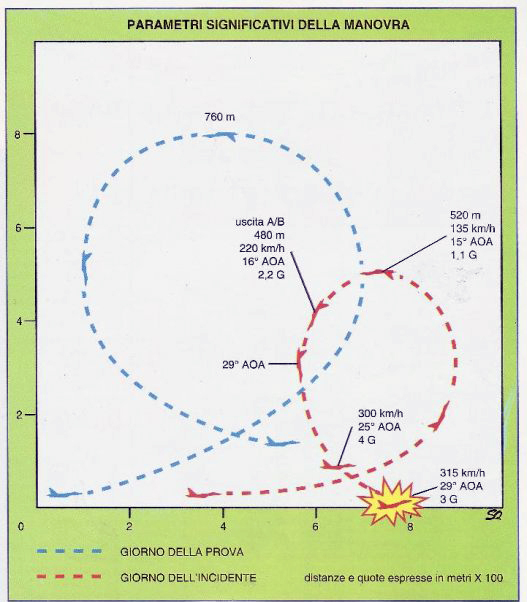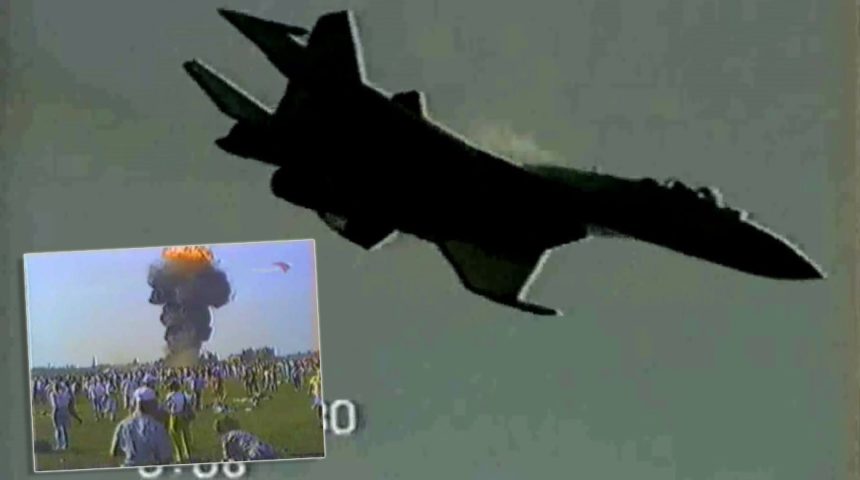The Flanker crashed into the ground killing the pilot and an airshow service member.
On Sept. 9, 1990, a Soviet Sukhoi Su-27 Flanker, crashed during an airshow held at Salgareda, a small airfield with a grass airstrip located near Treviso, in northeastern Italy. Lithuanian test pilot Rimantas Antanas Stankevichus, one of test pilots involved in “Buran” (Soviet “Space Shuttle”) program, was killed in the incident that also caused the death of a service member on the ground, who happened to be close to the place where the aircraft impacted the ground.
The display of the Soviet Flanker lasted just a few minutes.
According to the investigation, the pilot, who had taken off from Rivolto (home of the Frecce Tricolori display team) about 15 minutes before, struggled a bit to find the airshow location, although a rehearsal display had been flown the day before the incident. This was probably due to the fact that the airstrip, with a grass runway, and surrounded by green fields, could be difficult to spot from the air. Radio contact with the airshow manager was established when the aircraft was quite close to the display area: this, according to the inquiry, may have caused considerable stress to the pilot. Once “visual” with the runway, Stankiavichus performed a first passage with landing gear down, followed by a “positioning flyby”: the latter was conducted too close to the spectators and outside the “display box” agreed during the briefings. For this reason, the pilot was asked by radio to reposition and make another pass.
During the second pass, the Su-27 approached the runway with extended flaps and landing gear, at an altitude of 30-50 meters and a speed of 250 kmh. About halfway down the runway, the Flanker retracted the landing gear and flaps, applied afterburner thrust and started a loop. At the top of the loop, the aircraft was in reheat, flying at 135 km/h, 520 m of height, 15° AOA (Angle Of Attack) and 1.1g load factor. On the rehearsals day, the Su-27 had closed the loop with a top altitude of 760 m. At the 9 o’clock position in the loop, the Su-27 was at 350 m from the ground with the nose pointing to the ground: the pilot reduced the throttle pulling the control stick to the limits and inducing an AOA of 29°. At this point, the aircraft assumed a levelled attitude but with a vertical speed of 3,500 fpm, 29° AOA, 3.7g load factor and engines at 100% RPM. The impact occurred at 315 km/h.
The pilot did not attempt to eject.
The human factor was determined to be the root cause of the incident. Many other contributing factors were identified in the inquiry. Among them, the stress induced by the difficulties in locating the airfield and in talking with the ATC control (the pilot relied in translators because he didn’t know English nor Italian language); the request to perform a second pass because the first one was deemed too close to the spectators that may have put even more pressure on the pilot; the position of the sun and the lighting conditions which may have affected pilot’s ability to judge his actual height at the top of the loop.

The Su-27 Flanker crash at Salgareda, was a shock for the bystanders and for those who watched the tragic footage of jet impacting the ground. The Soviet aircraft was the highlight of the airshow and, back then, a pretty rare bird for most aviation enthusiasts and professionals.








